- Register
- Log in to Tune-In
- Wishlist (0)
-
Shopping cart
(0)
You have no items in your shopping cart.
Beatles News

As Catalan President Carles Puigdemont spoke at a press conference in Brussels, details emerged of a Madrid document that partly blames the current crisis in Spain on a number of well known people from around the world. The Spanish government specifically named WikiLeaks founder Julian Assange and artist Yoko Ono as encouraging the Catalan independence referendum.
Brussels press conference
At the press conference, Puigdemont made it clear he was not in Brussels to claim asylum:
He also said he accepted the snap election for Catalonia, imposed by Spanish Prime Minister Mariano Rajoy, on 21 December.
He added that he and his colleagues would return to Catalonia once it is guaranteed they could act “with freedom and without threats”.
Source: Tom Coburg
details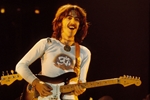
Although most of us might instantly jump to The Beatles when someone says George Harrison, in actual fact Harrison’s career took a leap almost as impressive in the 1990s.
After the release of his hit single I’ve Got My Mind Set On You in 1987, Harrison skyrocketed as a less than likely pop sensation of the time. He then jumped on the road for an unexpected tour alongside Eric Clapton across Japan in 1991.
Source: hhhappy.com
details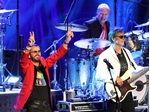
Fans are flocking to the Abraham Chavez Theater to see Ringo Starr and His All-Star Band.
A former member of The Beatles, Ringo is known for providing lead vocals in hits like "Yellow Submarine" and "Little Help From My Friends".
He last performed in El Paso in 2003. George Reynoso, owner of All That Music & Video, says none of the other band members have ever performed in El Paso.
"It's huge, especially if you're into The Beatles and Beatles music," Reynoso said.
Reynoso describes The Beatles as legendary. He says Ringo wasn't taken very seriously, after joining the band in 1962, replacing Pete Best.
"But in time as The Beatles gained credibility so did Ringo as the world's most very very highly respected musician drummer," Reynoso said.
Ringo performed in Las Vegas Sunday night. He's expected to sing his classics, along with songs from his solo records in El Paso Monday.
The show starts at 8 p.m. Doors open at 7 p.m.
Officials at the theater say they're expecting the show to be a sell-out.
details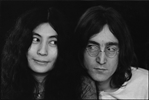
John Lennon’s Holiday Card to Yoko Ono’s Ex
During the holiday season of 1968, Yoko Ono’s second husband, Anthony Cox, received a card from Ono, then still his wife, and her boyfriend, John Lennon. In it, Lennon and Ono informed Cox that Ono had taken most of her things from her shared home with Cox—in other words, she was officially moving on with Lennon, whom she met in 1966. This card, not exactly full of holiday mirth, can now belong to a lucky Beatles fan for $15,000 via momentsintime.com.
Though that seems like a steep price for a Christmas card, the note does contain a bonus message for Cox, from Lennon. In a separate note written on Apple Records letterhead, Lennon asked Cox if he could send two of Ono’s short films and master tapes from a recent performance with jazz musician Ornette Coleman. “Also, we want to get on with producing Ornette-Yoko record under Apple before Easter. That will be very good,” he wrote.
Source: Hilary Weaver
details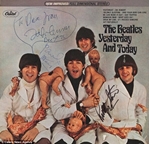
The rare pre-production Yesterday and Today album featured the butcher cover
Controversially, it showed Fab Four draped in meat and decapitated baby dolls
John Lennon's personal copy was salvaged by a fan who has put it up for auction
It will go under the hammer on November 11 in Dallas, TX, with a $200k estimate.
John Lennon's personal copy of a Beatles album with hand-drawn sketches dubbed the world's rarest album is set to fetch more than $200,000 as it goes up for auction.
The rare pre-production Yesterday and Today album with the infamous butcher cover will go up for auction on November 11 in Dallas, Texas.
It was John Lennon's personal copy and sports one of his illustrations on the back of a man with his shovel and a dog in front of a setting sun.
The Yesterday and Today prototype was pulled two days after its release because of the controversial cover artwork and all were destroyed apart from a few - including this one owned by Lennon himself - before a tamer version was hurriedly re-released.
Source: Gareth Davies For Mailonline

A set of unseen images of John Lennon, which were in a "junk drawer" for over 30 years because they were thought to have no value, have been unveiled.
The 26 negatives, dating from 1970, were brought to a valuation day at Liverpool's The Beatles Story museum.
Their owner said his late father may have come by them while studying art in the 1970s.
The "intimate portraits" were "a rare find" and could be worth £10,000, auctioneer Darren Julien said.
He added that it was "not often when you find images of John Lennon that have never before been seen by the public".
Source: BBC
details
Paul McCartney has paid tribute to late rock and roll icon Fats Domino, describing meeting his idol and calling him a “huge influence” on The Beatles.
Domino passed away on Tuesday (October 24) at the age of 89. He died of natural causes.
McCartney has now posted a tribute to his official website, calling Domino a “great rock ’n’ roll pianist and singer” and describing him as “truly magnificent”.
“We were excited to meet Fats once in his home town of New Orleans,” McCartney wrote. “He was wearing a huge star spangled diamond encrusted watch which was our first encounter with bling!”
Source: nme
details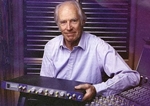
The Lebrecht Album of the Week has the first review of a premier album of orchestral and film music by George Martin, the Beatles’ man behind the glass wall.
How good a musician was the Beatles’ producer? I talked to George Martin three or four times and, while I found him very likeable, was unimpressed by his musical curiosity. Like many other producers I knew at Abbey Road, he was a purposeful fixer who knew what needed to be done to make a track work and which of London’s hundreds of freelancers he had to call in to patch up a session that, somehow, lacked the finishing touch. String quartet for ‘Yesterday’, piccolo trumpet for ‘Penny Lane’, George Martin knew who to call and how to integrate them. He had a quirky turn of mind, rather than an original concept.
Source: Slipped Disc
details
In 1971 John Lennon traded a rare, autographed copy of The Beatles Yesterday And Today compilation record for the infamous Yellow Matter Custard bootleg, a fan-taped reel-to-reel collection of early-Beatles radio performances that had never been commercially released. Now, Lennon’s personal copy of Yesterday And Today is expected to fetch nearly a quarter-million dollars at auction.
details
You could argue for the rest of your life about what constitutes the first rock’n’roll record and, indeed, on the internet, there are people prepared to do that. An exhaustive 82-track 2011 compilation comes up with candidates for the title, with varying degrees of plausibility, and with tunes dating back to 1915. But Fats Domino’s 1949 single The Fat Man has a stronger claim than most. Based on Junkers’ Blues, a 1940 track originally recorded by Champion Jack Dupree, there’s almost nothing to it. A pounding, unchanging backbeat and an insistent bass pulse; Domino on piano, playing in a style noticeably more aggressively than that of his peers; saxes and guitar buried so deep in the mix that you barely even spot them until the song’s finale; some falsetto scat singing and three verses that replace Junkers’ Blues’ references to cocaine, reefers and heroin with lyrics that laud both Domino’s bulk and his irresistible sexual abilities: “I weigh two hundred pounds, all the girls love me, because I know my way around.” It sold a million copies and transformed Domino overnight from the pianist in Billy Diamond’s Solid Senders, a locally popular New Orleans band, details
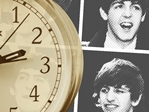
Everything fades, include The Beatles. At least according to Google data.
Interest in The Beatles is plunging dramatically on both Google and YouTube, according to data from the search giant. A quick look at Google Trends shows a fairly dramatic erosion in search traffic on both mainline search and YouTube, with drops reaching 70% since the early 2000s.
Here’s a look at overall Beatles searches on Google, worldwide, since 2004.
Source: digitalmusicnews.com
details
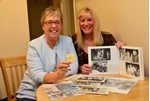
It was more than 50 years ago but the gigs The Beatles played in Gloucestershire are committed to many memories of gig-goers at the time – but where did the term Beatlemania come from?
It’s been claimed that the word used to describe the hysteria which followed the Fab Four everywhere they went was invented in Gloucestershire, after a gig in Cheltenham.
Former Citizen journalist Hugh Worsnip, who saw the Liverpudlian four piece play in Gloucester, said that according to the book Beatlemania by Martin Creasy the first mention of the word was in the Daily Mirror on November 3, 1963, following the opening night of the Beatles fourth tour at the Odeon in Cheltenham.
details

There never was a time like it for these boys. Just look at the joy in their smiles. So young and fresh-faced in their inexpensive suits and ties, sensible, unshowy haircuts and polished black shoes.
At a glance you might think they are a works football squad, celebrating, along with their young coach from accounts, a lucky away win in an amateur cup first round with a 'jump for joy' photo-shoot.
But look more closely and those four young men on the left may seem rather familiar. As well they might, because they are John Lennon, Ringo Starr, George Harrison and Paul McCartney.
What they are celebrating — along with their friends Gerry and the Pacemakers and Billy J. Kramer and the Dakotas — isn't goals, but No. 1 records in the pop charts.
Source: Ray Connolly For The Daily Mail
details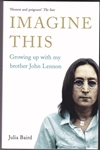
KENT — John Lennon’s sister and her children were watching a BBC documentary about her brother and the story couldn’t have been further from the truth, so she decided to write her own book to set the record straight.
At a concert with The Mersey Beatles on Saturday at Kent Stage, Julia Baird will meet with fans and sign copies of her book: “Imagine This: Growing Up with My Brother John Lennon” that knocks the biographies’ claims that John was abandoned by his mother.
“I think the Beatles are a modern-day Beethoven,” Baird said in an interview with Record-Courier. “People study the lives of the Beatles like they study the life of Beethoven. There’s books and biographies. Friends of friends of someone who knew them and they’re the ‘experts’ that write about John’s life. After John died, stories about our family became wild and he’s no longer around to do anything. I thought I’ve got to do something.”
Baird, the director of the Cavern Club, is on tour with The Mersey Beatles, a Liverpool-born Beatles tribute band and longtime house band at the world-famous club in England where the Beatles gigged before the details

This past Friday, Ringo Starr and his All Starr Band kicked off an eight-show Las Vegas residency at Planet Hollywood Resort & Casino, and the ex-Beatles drummer dedicated the show to the victims of the recent horrific mass shooting that took place in the city. He also made a personal donation the day before.
On Thursday, Starr and wife Barbara Bach donated $100,000 via their Lotus Foundation charity to the Nevada Resort Association’s just-launched Vegas Strong Fund, which supports the shooting victims and their families.
Matching the Starrs’ donation was Caesars Entertainment President and CEO Mark Frissora, whose company owns the Planet Hollywood resort. The $200,000 is part of a total of $2 million that Caesars Entertainment has contributed to the fund.
Source: columbusnewsteam.com
details